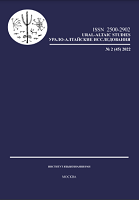Условное деепричастие в лесном диалекте энецкого языка: корпусное исследование системы употреблений
Conditional converb in Forest Enets: a corpus-based study of its system of uses
Author(s): Maria A. OvsyannikovaSubject(s): Phonetics / Phonology, Cognitive linguistics, Computational linguistics, Descriptive linguistics
Published by: Институт языкознания Российской академии наук
Keywords: conditional converb; conditional constructions; Enets; clause integration; grammaticalization;
Summary/Abstract: This corpus-based study examines the functions of the conditional converb in Forest Enets and investigates the differences in its use between two generations of Enets speakers. In line with the previous descriptions, independent clauses with conditional converbs are used as self-addressed questions (yes/no, special, and alternative questions). The conditional converb of the verb ɛ ‘be’ when used with numerals is developing into a marker of approximation. Dependent clauses with conditional converbs include protases of conditional and concessive conditional constructions as well as complement clauses. This study discusses the diachronic relation between independent clauses with conditional converbs and the protasis of conditional constructions and concludes that either of the two directions of development is possible. Complement clauses with conditional converbs include, first, irrealis complements to negative propositional attitude predicates (dʲɔxara ‘not know’, dʲurta ‘forget’), which, showing signs of relatively recent grammaticalization, have hitherto received scant attention by scholars, and, second, sentential subjects in modal constructions with such predicates as sɔjza ‘good’, bɔɔ ‘bad’ etc. To compare the use of the Enets conditional converb across types of clauses and generations of speakers, this paper analyses the occurrence of the future tense marker on the converb, the order of clauses in multi-clause constructions, the range of verbs in the main and in the dependent clauses. Many of these parameters can be interpreted as the signs of the growing level of clause integration in the process of grammaticalization of polypredicative constructions.
Journal: Урало-алтайские исследования
- Issue Year: 2022
- Issue No: 02 (45)
- Page Range: 106-122
- Page Count: 17
- Language: Russian

